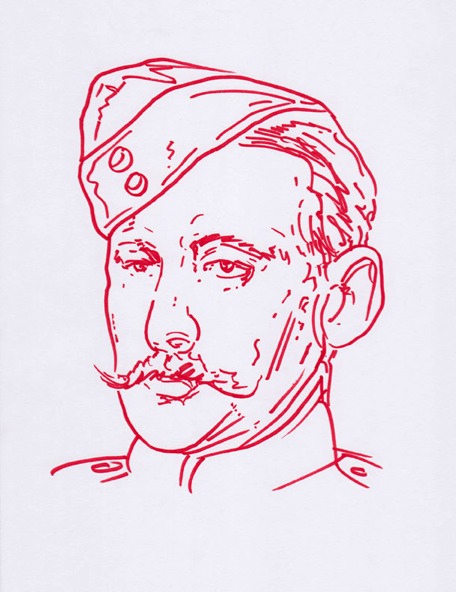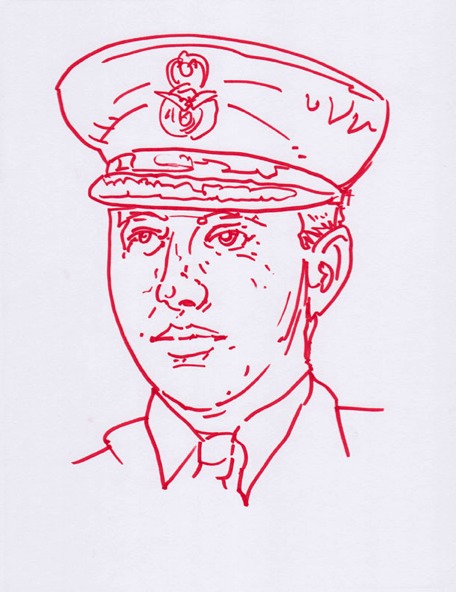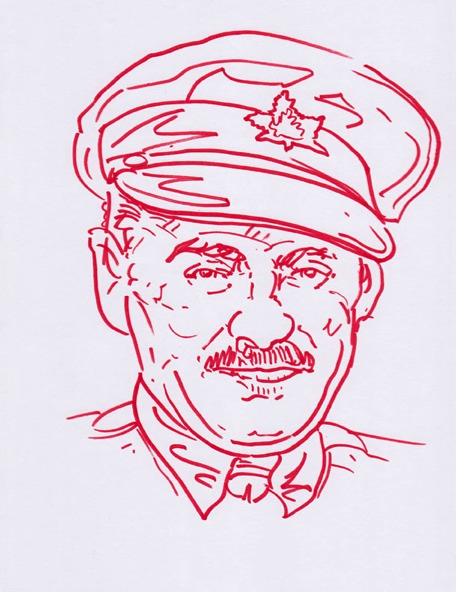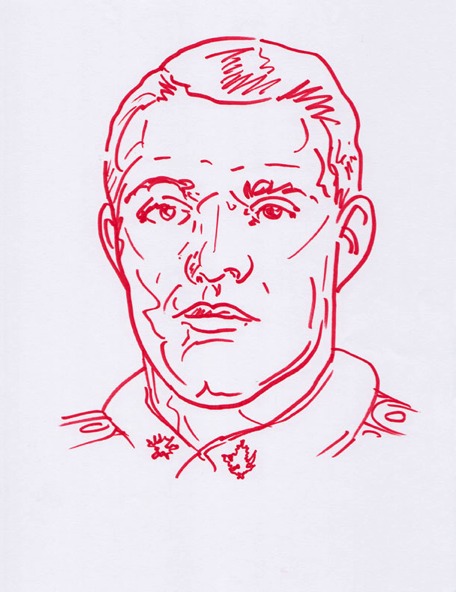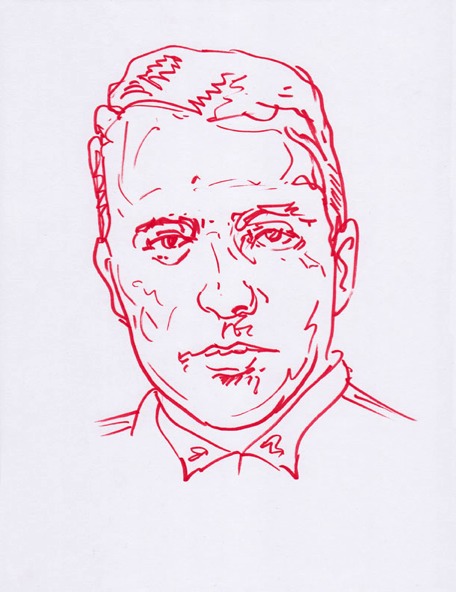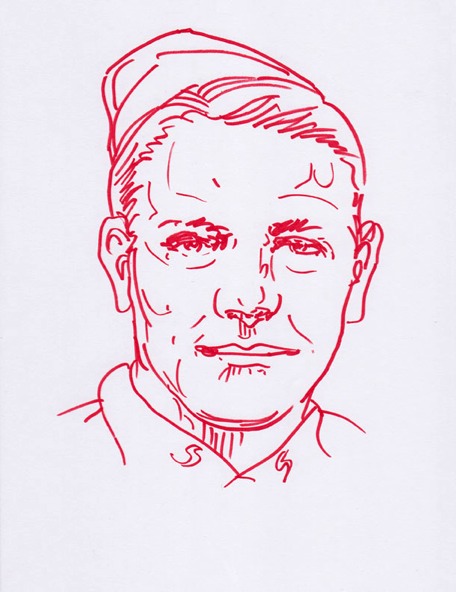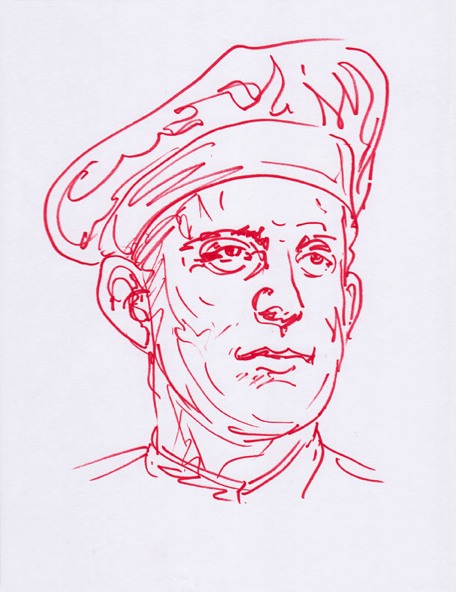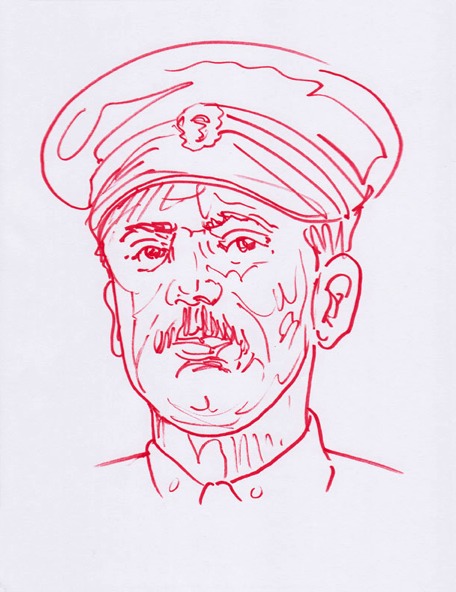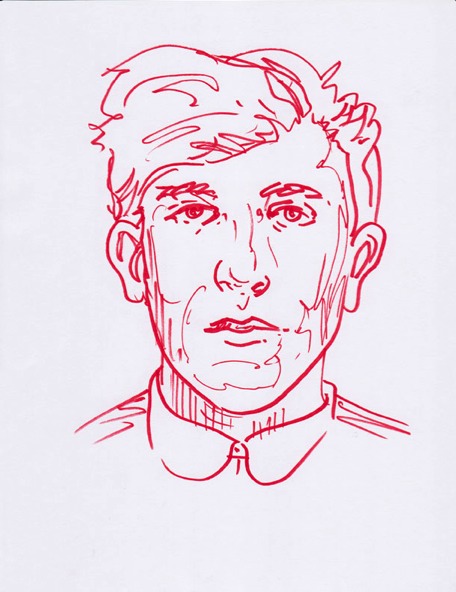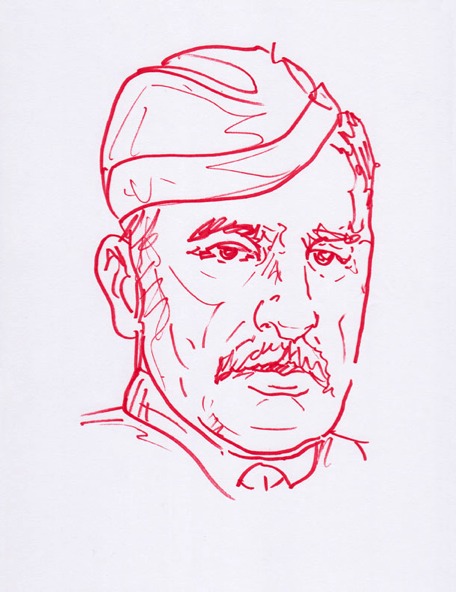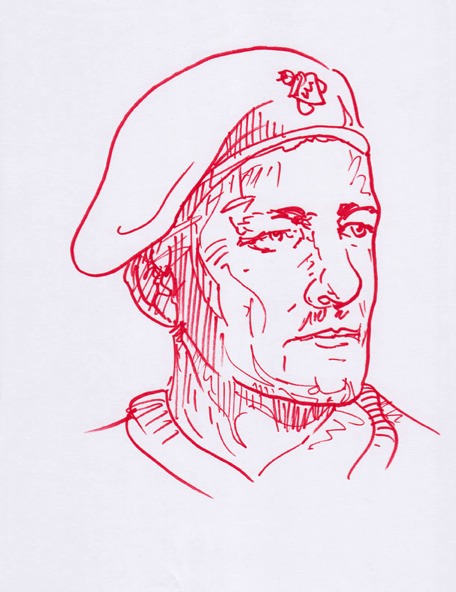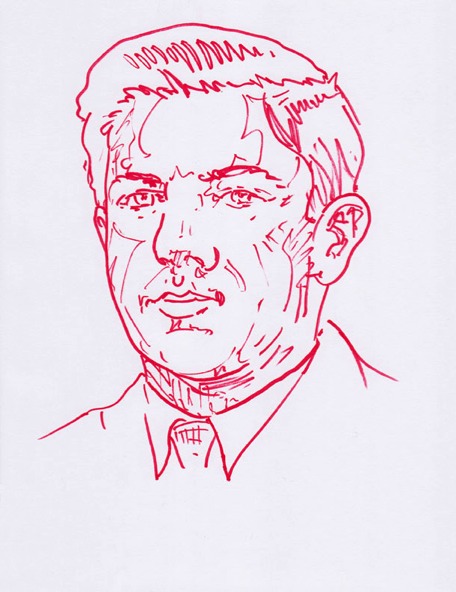
FOR VALOUR
The Recipients of the Victoria Cross Medal, Series 2011
Ink on 300lb. Cold-Pressed Rag Paper
21cm x 28cm (8.5" x 11")
98 Portraits were made over a period of 24 hours on Remembrance Day, November 11th 2011. (11.11.11)
[That was approximately 1 drawing produced every 15 minutes, continuously over that one 24 hour period].
Copyright © Andrew R. Hutchison 2011

Surgeon-General
Herbert Reade, VC
Born: Perth, Upper Canada, 20 Sept.1828
Died: Bath, Somerset, England, 23 June 1897
Unit: 61st Regiment. (later 'The Gloucestershire Regiment', British Army)
Reade was assisting the wounded at the Siege of Delhi, Sept. 14, 1857, when his position came under heavy fire. Armed with only a sword, he led a successful attack on the rebels turning the tide of the battle.

Lieutenant-Colonel
Campbell Douglas, VC
Born: Quebec City, 5 Aug. 1840
Died: Wells, Somerset, England, 31 Dec. 1909
Unit: 2nd Bn., 24th Regiment. of Foot (later 'The South Wales Boarders', British Army)
On May 7, 1867, a small party of Soldiers landed on Little Andaman, Bay of Bengal, and were quickly outnumbered by the attacking natives. Douglas alerted to this incident, took a small boat through a violent storm to assist, and managed to rescue many of the men involved.

Colonel
Alexander Dunn, VC
Born: York, Ont., 15 Sept. 1833
Died: Senafe, Ethiopia, 25 Jan. 1868
Unit: 11th Hussars (British Army)
At the Battle of Balaclava, Oct. 25, 1854, Dunn charged with only 600 comrades into a stalwart Russian defense of over 2500. British casualties were heavy in this terrible suicidal charge, but Dunn fought through the Russian line and succeeded in completing his mission.

Petty Officer First Class
William Hall, VC
Born: Horton Bluff, N.S., 28 April 1827
Died: Hantsport, N.S., 25 Aug. 1904
Unit: HMS Shannon, Royal Navy
During the 1857 Indian Mutiny, Hall went ashore as part of a gun crew. With men dying or wounded all around him, only he survived to keep their gun in action and single handily breached the wall of the fortress leading to its capture.

Captain
Raymond de Montmorency, VC
Born: Montreal, 5 Feb. 1867
Died: Dordrecht, Cape Colony, South Africa, 23 Feb. 1900
Unit: 21st Lancers (Empress of India - British Army)
At the Battle of Omdurman, Sept. 2, 1898, de Montmorency struck out on his own in a hail of gun-fire to assist a surrounded 2nd Lieut. R.G. Grenfell. Raymond de Montmorency managed to drive the enemy off, but finding Grenfell dead; de Montmorency laid Grenfell's body on the back of his horse and sent it out of the path of danger, then quickly rejoined his comrades in the fight.

Major
Hampden Cockburn, VC
Born: Toronto, 19 Nov. 1867
Died: Grayburn, Sask., 13 July 1913
Unit: Royal Canadian Dragoons
On Nov. 7, 1900, near Lillefontain, South Africa, a Canadian force acted as the rearguard to allow a British formation to retreat to safety. Cockburn, with a few men, held off the Boers, fought severely outnumbered allowing time for a counter attack by the Allied Forces. Shot twice, he survived to join the counter strike despite being the only member of his unit remaining alive and survived that next battle as well ...with the bullets still in him.

Lieutenant-Colonel
Edward Holland, VC
Born: Ottawa, 2 Feb. 1878
Died: Cobalt, Ont., 18 June 1948
Unit: Royal Canadian Dragoons
On Nov. 7, 1900, near Lillefontain, South Africa, as part of a rearguard action, Holland used his machine to protect two 12-pounder field guns that were firing on Boer command positions. Once he succeeded in protecting his fellow soldiers which his actions, he quickly picked up his hot gun jumped on a horse and rounded up 2 badly wounded prisoners while in full gallop, returned to base with the battle won and the 2 prisoners still alive.

Lieutenant-General
Richard Turner, VC
Born: Quebec City, 25 July 1871
Died: Quebec City, 29 June 1961
Unit: Royal Canadian Dragoons
On Nov. 7, 1900, near Lillefontain, South Africa, as part of a rearguard, Turner led troops to prevent the capture of the guns of D Batt., RCFA. Though shot earlier in the day, Turner managed to lead the ambush to subdue the enemy in a vicious fight despite being heavily outnumbered.

Major-General
William Nickerson, VC
Born: Dorchester, N.B., 27 March 1875
Died: Cour, Kintyre, Scotland, 10 April 1954
Unit: Royal Army Medical Corps, British Army
At Wakkerstroom, South Africa, on April 20, 1900, during the British assault on Bwab's Hill, a Worcestershire Regt. Soldier was severely wounded and could not be moved. Under heavy fire, Nickerson dressed the man's wounds and remained with him until he could be safely removed.

Sergeant
Arthur Richardson, VC
Born: Southport, Lancashire, U.K., 23 Sept. 1872
Died: Liverpool, England, 15 Dec. 1932
Unit: Lord Strathcona's Horse (Royal Canadians)
On July 5, 1900, Wolve Spruit, South Africa, 38 Strathcona's engaged a larger Boer party before retiring. Richardson stayed to rescue a wounded trooper trapped under his wounded horse. Under heavy fire, Richardson freed the man and then rode away with him on his own wounded horse.

Captain
Edward Bellow, VC
Born: Bombay, India, 28 Oct. 1882
Died: Kamloops, B.C., 1 Feb. 1961
Unit: 7th Bn., CEF
On April 24, 1915, during 2nd Ypres, Bellow was machine-gun officer in charge of two gun positions. A major German attack outflanked the Canadian position but Bellow and Sergeant Peerless stayed and fought. Peerless died, but Bellow, though badly wounded, resisted until he ran out of ammo. He destroyed his guns before being captured.

Lieutenant-Colonel
Philip Bent, VC
Born: Halifax, 3 Jan. 1891
Died: Poygon Wood, Zonnebeke, Belgium, 1 Oct. 1917
Unit: 9th Bn., Athens Leicestershire Regt., British Army
A major counterattack by the Germans Oct., 1, 1917, pushed back part of Bent's unit and battalion on his right. Under heavy fire, Bent collected a reserve platoon and other men to prevent a total collapse. The counterattack led by Bent restored the line, but he was killed in the effort.

Air Marshal
William Bishop, VC
Born: Owen Sound, Ont., 8 Feb. 1894
Died: Palm Beach, Fla., 11 Sept. 1956
Unit: RFC
While flying behind German lines near Cambrai, France, June 2, 1917, Bishop executed a solo attack on the enemy aerodrome. After strafing the field and destroying five aircraft, a number of German plains attacked. Bishop engaged seven aircraft and shot down three before escaping. Bishop's had been severely shot up, but he survived unscathed.

Lieutenant
Wallace Algie, VC
Born: Alton, Ont., 10 June 1891
Died: Cambrai, France, 11 Oct. 1918
Unit: 20th Bn., CEF
Exploiting a bridgehead across the Canal de I'Escaut, Oct. 11, 1918, Algie shot a German machine-gun crew and turned the gun on the enemy to allow his men into Iwuy. He killed another gun crew and captured 11 prisoners to complete the clearance of the village. He was later killed that same day.

Lieutenant-Colonel
William Barker, VC
Born: Dauphin, Man., 3 Nov. 1894
Died: Ottawa, 1 March 1930
Unit: RAF
While patrolling the air over France, Oct. 27, 1918, Barker shot down an enemy two-seater. He was later wounded by a Fakker Biplane which he also shot down. Twice attacked by large formations and severely wounded, he escaped, shooting down 4 more enemy planes. He reached Allied lines, but only after engaging after engaging another hostile formation.

Sergeant
Colin Barron, VC
Born: Baldavie, Scotland, 20 Sept. 1893
Died: Toronto, 15 Aug. 1958
Unit: 3rd Bn., CEF
On Nov. 6, 1917, at Passchendale, Barron's unit was ordered to capture a German pillbox blocking the advance. He attacked three machine guns holding up his unit, killed four of the crew and captured the rest. He used one of the captured guns to inflict heavy casualties on the retreating enemy.

Commander
Roland Bourke, VC
Born: Kensington, England, 28 Nov. 1885
Died: Esquimalt, B.C., 29 Aug. 1958
Unit: RNVR
At the Second Ostend Raid of May 9-10, 1918, Bourke, commanding ML 276, entered the harbor to ensure the crew of HMS Vindictive had been rescued. On his second trip in he found three men clinging to an overturned boat. ML 276 was under very heavy fire and hit 55 times, but Bourke steered to open water.

Sergeant
Alexander Brereton, VC
Born: Oak River, Man., 13 Nov. 1892
Died: Calgary, 11June 1976
Unit: 8th Bn., CEF
On Aug. 9, 1918, during the Amiens offensive, Brereton's platoon was stopped by German machine-gun fire near Warvillers and Vrely. Recognizing the danger, Brereton single-handedly changed the German position where he shot the machine gunner and bayoneted two others. His actions prompted nine enemy soldiers to surrender.

Lieutenant
Jean Brillant, VC
Born: Assemetquaghan, Que., 15 March 1890
Died: near Villers-Bretonneux, France, 10 Aug. 1918
Unit: 22nd Bn., CEF
Brillant was wounded Aug. 8, 1918, while destroying a German machine-gun position, killing four of its crew. He was again wounded that day while leading an attack where five machine guns and 150 soldiers were captured. He was later mortally wounded and died two days later.

Corporal
Harry W. Brown, VC
Born: Gananoque, Ont., 10 May 1898
Died: Bethune, France, 17 Aug. 1917
Unit: 10th, Bn., CEF
At Hill 70, August 1917, Brown's unit held, but was cut off in an exposed quarry when Germans counterattacked. Brown and another soldier were sent to the rear to get help. The other soldier was killed, but Brown - severely wounded - delivered his message before collapsing. He died a few hours later.

Sergeant
Hugh Cairns, VC
Born: Ashington, Northumberland, England, 4 Dec. 1896
Died: near Douai, France, 2 Nov. 1918
Unit: 46th Bn., CEF
Cairns displayed great valour in the Battle for Valenciennes, Nov. 1, 1918. He destroyed numerous German machine guns, killing the crew and capturing over 100 prisoners. He was severely wounded but managed to disarm 60 enemy soldiers, and returned returned to the battle, but collapsed and died the next day.

Lieutenant
Frederick Campbell, VC
Born: Mount Forest, Ont., 15 June 1867
Died: Boulogne, France, 19 June 1915
Unit: 1st Bn., CEF
At Givenchy, June 15, 1915, Campbell advanced his machine guns to the enemy's front line. With most of his detachment killed or wounded, he fired his gun under heavy German fire, and then moved forward to hold back a major counterattack. Hit in the leg, he died four days later.

Corporal
Frederick Coppins, VC
Born: London, England, 25 Oct. 1889
Died: San Fancisco, California, 30 March 1963
Unit: 8th Bn., CEF
On Aug. 9, 1918, during the Amiens offensive, Coppins's platoon was surprised by German machine guns. Without cover and unable to retire, he called on four men to join a charge on the guns. Wounded and with his men dead, he managed to kill the machine gunner and three more before capturing four others.

Private
John Croak, VC
Born: Little Bay, Nfld., 18 May 1892
Died: near Amiens, France, 8 Aug. 1918
Unit: 13th Bn., CEF
Separated from his unit on the opening day of the Battle of Amiens, Croak bombed a machine-gun nest, capturing the crew and their gun. Reunited with his platoon and severely wounded, he led an attack that killed the crew and captured three other machine guns. Croak was again wounded and later died.

Major
Robert Cruickshank, VC
Born: Winnipeg, Mn., 17 June 1888
Died: Blaby, Leicestershire, U.K., 1 Sept. 1961
Unit: 2/14th Bn., The London Regt. (London Scottish)
East of Jordan, Palestine, May 1, 1918, Cruickshank's platoon was in a wadi under heavy fire. He volunteered to run for help, but was wounded each time he attempted to crawl out of the wadi. Unable to stand, he remained in the vulnerable position all day and night, wounded once more but survived the ordeal.

Lieutenant
Gordon Flowerdew, VC
Born: Billingford, Norfolk, England, 2 Jan. 1885
Died: Moreuil Wood, France, 31 March 1918
Unit: Lord Strathcona's Horse (Royal Canadians)
In "The Last Great Cavalry Charge," Flowerdew ordered three troops of his squadron to attack two lines of German infantry that we're preparing to take Moreuil Wood. Flowerdew's charge caused heavy casualties on both sides, but forced the enemy to retire. Flowerdew was mortally wounded in the action.

Corporal
Herman Good, VC
Born: Big River, N.B., 18 Nov. 1892
Died: Bathurst, N.B., 18 April 1969
Unit: 13th Bn., CEF
On the first day of the Battle of Amiens, Aug. 8, 1918 - when his company was held up by three machine guns near Hangard Wood - Good dashed forward alone and killed or captured the German garrison. That same day he led a charge on a gun battery, capturing the crews of three guns.

Brigadier
Milton Gregg, VC
Born: Mountain Dale, N.B., 10 April 1892
Died: Fredericton, 13 March 1978
Unit: RCR, CEF
During an attack near Cambrai, France, Sept. 28 - Oct. 1, 1918, Gregg crawled forward alone to find a gap in the wire. He then led his men to capture and hold the trench against determined counterattacks. Though wounded, Gregg remained at the front and led by example until seriously wounded two days later.

Corporal
Leo Clarke, VC
Born: Waterdown, Ont., 1 Dec. 1892
Died: near Courcelette, France, 19 Oct. 1916
Unit: 2nd Bn., CEF
On Sept. 9, 1916, at the Battle of Courcelette, Clarke was ordered to build a trench block to protect his battalion's left flank. Finding the position occupied, the men fought to clear the enemy and only Clarke was left unfounded. A counterattack was repelled by Clarke's exceptional bravery. He was killed in action a month later.

Lieutenant-Colonel
William Clark-Kennedy, VC
Born: Ayrshire, Scotland, 3 March 1879
Died: Montreal, 25 Oct. 1961
Unit: 24t h Bn., CEF
Clark-Kennedy earned the VC for his initiative, bravery and battalion leadership during operations Aug. 27-28, 1918, at the Second Battle of Arras. He kept control during the battalion's advance, despite being severely wounded, and refused medical evacuation, preferring to organize his troops into a strong line of defense.

Lieutenant
Robert Combe, VC
Born: Aberdeen, Scotland, 5 Aug. 1880
Died: near Acheville, France, 3 May 1917
Unit: 27th Bn., CEF
In the battle to capture Fresnay, May 3, 1917, Combe led his company forward under heavy fire but reached the objective with only five men. Nevertheless he bombed the enemy, inflicting severe casualties. He secured the objective and captured 80 prisoners. In a subsequent charge, he was killed by a sniper.

Second Lieutenant
Edmund De Wind, VC
Born: Camber, County Down, Ireland, 11 Dec. 1883
Died: near St. Quentin, France, 21 March 1918
Unit: 15th Bn., Royal Irish Rifles, British Army
Directly in the path of the March 21, 1918, German offensive, De Wind - for seven hours - helped defend a redoubt from attack while awaiting reinforcements. Twice he left his position to clear enemy from a trench. While repelling attack after attack, he was mortally wounded.

Lieutenant
Thomas Dinesen, VC
Born: Rungsted, Denmark, 9 Aug. 1892
Died: Vejile, Denmark, 10 March 1979
Unit: 42nd Bn., CEF
Near the end of the Amiens offensive, Dinesen captured over a mile of strongly defended German trenches near Parvillers. In a 10-hour period, he single handedly rushed forward five times to effectively deal with German machine-gun positions. His actions inspired all those around him.

Lance-Corporal
Frederick Fisher, VC
Born: St.Catherines, Ont., 3 Aug. 1894
Died: near St. Julien, Belgium, 24 April 1915
Unit: 13th Bn., CEF
The first German gas attack at the 2nd a battle of Ypres created a gap in the allied line.
Fisher advanced into this with is machine-gun team. With his crew dead, he manned the gun, preventing a German advance and allowing the 10th Field Battery to withdraw. Fisher was killed in action the next day.

Sergeant
Frederick Hobson, VC
Born: London, England, 23 Sept. 1873
Died: near Lens, France, 18 Aug. 1917
Unit: 20th Bn., CEF
At Hill 70, Hobson saw a Lewis gun crew killed by a shell. He dug out the buried gun and used it against advancing enemy. When it jammed, he rushed forward to continue to fight. He died, but his actions bought time to get the gun back into action, saving further casualties.

Private
Thomas Holmes, VC
Born: Montreal, 14 Oct. 1898
Died: Toronto, Ont., 4 Jan. 1950
Unit: 4th CMR, CEF
On Oct. 26, 1917, at Passchendale, Holmes' battalion was was under heavy fire from a pillbox. Alone and on his own, he ran forward and used grenades to kill the machine-gun crews. He attacked the pillbox and after throwing another grenade accepted the surrender of 19 enemy, allowing the battalion to advance.

Lieutenant
Samuel Honey, VC
Born: Conn, Ont., 1 Sept. 1888
Died: near Bourlon Wood (Bois de Bourlon), 30 Sept. 1918
Unit: 78th Bn., CEF
At Bourlon Wood, Sept. 27-30, 1918, Honey took command of his company after the officers became casualties. He continued the advance and personally captured a machine-gun nest and 10 prisoners. Repelling four counterattacks, he led in the capture of a machine-gun post he had located during a reconnaissance. He later died of his wounds.

Private
John Keer, VC
Born: Fox River, N.S., 11 Jan. 1887
Died: Port Moody, B.C, 19 Feb. 1963
Unit: 49th Bn.,CEF
At Courcelette, France, Sept. 16, 1916, Kerr was part of a bombing party advancing to a German trench. He found himself ahead of his group and began exchanging grenade and rifle fire with the enemy. Thinking they had been surrounded, 62 enemy surrendered to Kerr who escorted them to Canadian lines.

Private
Cecil Kinross, VC
Born: Hillhead, Scotland, 13 July 1897
Died: Lougheed, Alta., 21 June 1957
Unit: 49th Bn., CEF
Near Passchendaele, Belgium, Oct. 30, 1917, the 49th Bn. Was stopped by artillery and machine-gun fire. After surveying the situation, Kinross - armed with a rifle and bandolier of ammunition - advanced over open ground. He charged a machine-gun, killed six crew and destroyed the gun, inspiring his unit to advance and occupy important ground.

Sergeant
Arthur Knight, VC
Born: Hayward's Heath, Sussex, England, 26 June 1886
Died: near Villers-les-Cagnicourt, France, 3 Sept. 1918
Unit: 10th Bn., CEF
At the Drocourt-Queant Line, Sept. 2, 1918, Knight bayoneted several German machine-gun and mortar crews, and inflicted heavy casualties on retreating enemy. He killed or captured a German party in a tunnel, and routed a party opposing the advance. He was fatally wounded later that day.

Company Sergeant-Major
Frederick Hall, VC
Born: Kilkenny, Ireland, 8 Feb. 1885
Died: near St. Julien, Belgium, 25 April 1915
Unit: 8th Bn., CEF
At the 2nd Battle of Ypres, Hall twice went forward in one day to bring back wounded men. The next day he went again - under heavy fire - to rescue a man just 15 yards from the trench. As he lifted the man to bring him back, he was mortally wounded.

Lieutenant
Robert Hanna, VC
Born: Kilkeel, Ireland, 6 Aug. 1887
Died: Mount Lehman, B.C., 15 June 1967
Unit: 29th Bn., CEF
At Hill 70 near Lens, Sept. 21, 1917, Hanna's company was ordered to capture a strongpoint. Three attempts were repelled with heavy casualties, including the unit's officers. Hanna collected a group of men and - under heavy fire - attacked again. He bayoneted three and clubbed a fourth allowing the capture of the position.

Brigadier-General
Frederick Harvey, VC
Born: Athboy, Ireland, 1 Sept. 1888
Died: Fort Macleod, Alta., 24 Aug. 1980
Unit: Lord Strathcona's Horse (Royal Canadians)
At Guyencourt, France, March 27, 1917, Harvey's unit was held up by German fire that caused heavy casualties. Without hesitation he led his men by running and jumping over barbed wire protecting the German position. He shot the machine gunner and captured his gun, which allowed his men to continue the advance.

Captain
Bellenden Hutcheson, VC
Born: Mount Carmel, Ill., 16 Dec. 1883
Died: Cairo, Ill., 9 April 1954
Unit: CAMC (attached to 75th Bn.), CEF
At the Drocourt-Quéant Line, Sept. 2, 1918, Hutcheson, a medical officer, treated wounded with utter disregard for his own safety. He assisted a seriously wounded high ranking officer and saw him evacuated while his stretcher-bearer party suffered heavy casualties. Also under fire, he later treated a sergeant-major in a shell hole saving yet another life.

Corporal
Joseph Kaeble, VC
Born: Saint-Moise, Quebec., 5 May 1893
Died: near Arras, France, 9 June 1918
Unit: 22nd Bn., CEF
During a heavy bombardment preceding an enemy trench raid, June 8-9, 1918, all the men except one from Kaeble's section became casualties. Armed with a Lewis gun, Kaeble fired continuously into advancing enemy. He was morally wounded, but continued to encourage his men, contributing to the repulse of the enemy.

Captain
George Kerr, VC
Born: Deseronto, Ont., 8 June 1894
Died: Toronto, 8 Dec. 1929
Unit: 3rd Bn., CEF
Nursing an injured arm, Kerr led his company at Bourlon Wood, Sept. 27, 1918. With great skill, he and his men outflanked a machine-gun position. Later, when the advance was stalled, he moved far in advance of his company and personally rushed a strongpoint, capturing four machine guns and 31 prisoners.

Sergeant
Filip Konowal, VC
Born: Podolsky, Urkraine, Russia, 15 Sept. 1888
Died: Ottawa, Ont., 3 June 1959
Unit: 47th Bn., CEF
At Hill 70 near Lens, France, from Aug. 22-24, 1917, Konowal was an outstanding section commander who successfully directed his men to overcome tough resistance. More than once he attacked German machine-gun positions, bayoneting the crews and capturing the hubs. He killed several enemy before a serious wound ended his battle.

Major
Okill Learmonth, VC
Born: Quebec City, 22 Feb. 1894
Died: near Loos, France, 19 Aug. 1917
Unit: 2nd Bn., CEF
His company surprised by a German attack east of Loos, Aug. 18, 1917, Learmonth reacted instantly and charged the enemy, blunting its attack. Though mortally wounded, he fought on from the parapet, bombing the enemy and even catching their grenades and throwing them back. Too weak to carry on himself, he refused evacuation, preferring to spur on his troops with a suicidal final charge.

Colonel
Graham Lyall, VC
Born: Manchester, England, 8 March 1892
Died: Mersa Matruh, Egypt, 28 Nov. 1941
Unit: 102nd Bn., CEF
At Bourlon Wood, France, Sept. 27, 1918, Lyall maneuvered his platoon to outflank a position holding up the advance, capturing 13 prisoners, a field gun and four machine guns. He personally rushed a strongpoint, killing the officer and capturing 45 prisoners and five machine guns. He later captured 47 more Germans to consolidate his platoon's position.

Lieutenant-Colonel
Thain MacDowell, VC
Born: Lachute, Que., 16 Sept. 1890
Died: Nassau, Bahamas, 29 March 1960
Unit: 38th Bn., CEF
While separated from their unit at Vimy Ridge, April 9, 1917, MacDowell and two runners used hand grenades to knock out two German machine-gun positions. They discovered a large dugout and tunnel, and by creating the impression he had a larger force, MacDowell convinced two officers and 75 men to surrender.

Lieutenant-Colonel
John MacGregor, VC
Born: Cawdor, Scotland, 1 Feb. 1889
Died: Powell River, B.C., 9 June 1952
Unit: 2nd CMR, CEF
Highly decorated and promoted, MacGregor earned the VC for actions at the Hindenburg Line, Sept. 29 to Oct. 3, 1918. Leading his company under fire, he ran forward and personally put German machine-gun crews out of action. After a solo daylight reconnaissance he led his company into Neuville St. Remy, assisting the Canadian advance into Tilloy.

Captain
George McKean, VC
Born: Wellington, England, 4 July 1988
Died: Brighton, England, 28 Nov. 1926
Unit: 14th Bn., CEF
Near Gavrelle, France, April 27-28, 1918, McKean's scouting party encountered a trench block. Realizing that it jeopardized the operation, he leapt over it. And landed on a German soldier who he shot along with another soldier. After removing the blockage, he bombed forward where he rushed a second block and destroyed two machine-gun positions.

Lieutenant
Hugh McKenzie, VC
Born: Inverness, Scotland, 5 Dec. 1885
Died: Passchendaele, Belgium, 30 Oct 1917
Unit: CMGC, CEF
In command of a section of four machine guns accompanying an infantry attack at Meetscheele Spur, McKenzie's leadership kicked in when the infantry lost all of its officers and most of its NCOs. He took command, reconnoitered the position and organized successful flanking attacks. He died leading the frontal assault on the objective.

Lieutenant
Alan McLeod, VC
Born: Stonewall, Man., 20 April 1899
Died: Winnipeg, 6 Nov. 1918
Unit: RAF
While over Albert, France, March 27, 1918, McLeod and his observer, Second Lieutenant Arthur Hammond, were attacked by eight enemy scouts. McLeod's skillful piloting allowed Hammond to shoot down three, but both men were wounded and their aircraft set on fire. McLeod crash-landed and then managed to pull Hammond from the burning wreck.

Sergeant
William Merrifield, VC
Born: Brentwood, England, 9 Oct. 1890
Died: Toronto, 8 Aug. 1943
Unit: 4th Bn., CEF
During an assault on the Marcoing Line near Abancourt, France, Oct. 1, 1918, Merrifield single-handedly attacked two machine-gun posts holding up his unit. He was wounded destroying the first position, but continued on to destroy the second strongpoint. He refused to be evacuated and led his unit until he was severely wounded.

Lance-Corporal
William Metcalf, VC
Born: Waite Township, Maine, 29 Jan. 1885
Died: Eastport, Maine, 8 Aug. 1968
Unit: 16 Bn., CEF
At the Drocourt-Quéant Line, Sept. 2, 1918, Metcalf's battalion was held up by German defenses. Leaving his shelter, he used a single flag to direct a tank along the German front-line trench to destroy the strongpoint. It was later discovered that 17 machine guns had been trained on Metcalf and the tank.

Private
William Milne, VC
Born: Lanarkshire, Scotland, 21 Dec. 1892
Died: Vimy Ridge, France, 9 April 1917
Unit: 16th Bn., CEF
At Vimy Ridge, Private Milne undertook the task to take the machine gun firing on his battalion. He approached the gun on his hands and knees and used a bomb to destroy the crew and the gun. He stalked a second gun I'm the same manner and put it out of action. Milne was later killed in action.

Corporal
Harry Miner, VC
Born: Raleigh County, Ont.,24 June 1891
Died: near Amiens, France, 8 Aug. 1918
Unit: 58th Bn., CEF
During the Amiens offensive, Aug. 8, 1918, Miner attacked a machine-gun post single handedly. He killed the crew and turned the weaponry on the enemy. He destroyed a second machine-gun post with the help of two others, and was mortally wounded in another attack which saw him bayonet two enemy soldiers and put the rest to flight.

Lieutenant-Colonel
Coulson Mitchell, VC
Born: Winnipeg, 11 Dec. 1889
Died: Mount Royal, Que., 17 Nov. 1978
Unit: 4th Cdn. engineers, CEF
On Oct. 8-9, 1918, Mitchell led a party to examine bridges over a canal near Cambrai, France. With one bridge blown, he cut the leads to explosive charges on a second. He was attacked while cutting the wires to explosives on the main bridge, but helped defeat the attack and protect the bridge until reinforced.

Major
George Mullin, VC
Born: Portland, Ore., 15 Aug. 1892
Died: Regina, 5 April 1963
Unit: PPCLI, CEF
Near Passchendaele, Belgium, Oct. 30, 1917, Mullin led an attack on a pillbox position holding up his unit. He alone reached the roof and killed the enemy sniper before using his revolver to shoot two machine gunners. Mullin found an entrance to the pillbox and convinced its 10 occupants to surrender.

Private
Claude Nunney, VC
Born: Dublin, Ireland, 24 Dec. 1892
Died: Vis-en-Artois, France, 18 Sept. 1918
Unit: 38th Bn., CEF
Nunney was in company headquarters near the Drocourt-Quéant, Sept. 1-2, 1918, when the Germans laid down a heavy barrage and counterattacked. He went forward alone thought the barrage to encounter the men of his battalion. The next day he repeated his fearless actions, but was gravely wounded. He died 16 days later.

Major
Christopher O'Kelly, VC
Born: Winnipeg, 18 Nov. 1895
Died: Lac Seul, Ont., 15 Nov. 1922
Unit: 52nd Bn., CEF
On Oct. 26, 1917, O'Kelly led his company more than a kilometer into German defenses on a spur near Passchendaele, Belgium. He and his men captured six pillboxes, 10 machine guns and 100 prisoners and fended off counterattacks until relieved. At night they captured a raiding party of 11 men and a machine gun.

Major
Michael O'Leary, VC
Born: County Cork, Ireland, 29 Sept. 1888
Died: London, England, 2 Aug. 1961
Unit: Irish Guards, British Army
On Feb. 1, 1915, O'Leary's company was ordered to retake a position near Cuinchy, France, that had been lost to a counterattack. O'Leary charged past his men and killed a five-man machine gun crew, and then killed three more Germans and captured a machine gun and two prisoners at another emplacement.

Private
Michael O'Rourke, VC
Born: Limerick, Ireland, 19 March 1878
Died: Vancouver, 6 Dec. 1957
Unit: 7th Bn., CEF
At Hill 70 near Lens, France, Aug. 15-17, 1917, O'Rourke constantly risked his life as a stretcher-bearer to help the wounded. He was knocked down and partially buried by shells and repeatedly exposed himself to danger to rescue wounded soldiers, including one man who had been left behind.

Private
John Pattison, VC
Born: Woolwich, England, 8 Sept. 1875
Died: Lens, France, 3 June 1917
Unit: 50th Bn., CEF
At Vimy Ridge, April 10, 1917, Pattison noticed troops being held up a Sherman machine-gun position. Under heavy fire he moved from shell hole to shell hole to get close to the position. He used bombs to kill and wound some of the crew before charging and finishing the job with his bayonet.

Major-General
George Pearkes, VC
Born: Watford, England, 26 Feb. 1888
Died: Victoria, 30 May 1984
Unit: 5th CMR, CEF
At Passchendaele, Belgium, Oct. 30-31, 1917, Pearkes was wounded just before going into action, but led his company to capture two forms. Source Farm was the objective of a British division, but it's capture was essential to the Canadian advance. Through his determined leadership, Pearkes maintained his exposed position against strong counterattacks.

Lieutenant-Colonel
Cyrus Peck, VC
Born: Hopewell, N.B., 26 April 1871
Died: Sidney, B.C., 27 Sept. 1956
Unit: 16th Bn., CEF
On Sept. 2, 1918, at Cognicourt, France, Peck led his battalion to capture an objective. With his unit held up by machine-gun fire, he went forward at great risk to view the situation. He pushed his unit forward, and later braved intense enemy fire to direct tanks in support a neighbouring Canadian battalion.

Captain
Walter Rayfield, VC
Born: Richmond-on-Thames, England, 7 Oct. 1881
Died: Toronto, 19 Feb. 1949
Unit: 7th Bn., CEF
Rayfield demonstrated initiative and bravery during the attack on Villers-lez-Cognicourt, Sept. 2-4, 1918. He personally rushed a trench, bayoneted two Germans and took 10 prisoners. He out-dueled a German sniper, rushed the enemy line and captured 30 prisoners, and risked his life to rescue a badly wounded comrade.

Private
James Richardson, VC
Born: Lanarkshire, Scotland , 25 Nov. 1895
Died: near Courcelette, France, 9 Oct. 1916
Unit: 16th Bn., CEF
At Ancre Heights on the Somme, Piper Richardson played for his company during its attack on Regina Trench. Held up by severe gunfire, he stood in full view of the enemy and played. This inspired the men to capture the objective. Richardson helped recover wounded, but died trying to retrieve his bagpipes.

Sergeant
Thomas Ricketts, VC
Born: Middle Arm, White Bay, Nfld., 15 April 1901
Died: St. John's, 10 Feb. 1967
Unit: Royal Newfoundland Regt.
Ricketts volunteered to go forward with his section commander to outflank an artillery battery holding up the advance near Ledegham, Belgium, Oct. 14, 1918. After doubling back under fire to rearm, Ricketts pinned down enemy, leading to the capture of four field guns, four machine guns and eight prisoners.

Private
James Robertson, VC
Born: Albion Mines, N.S., 26 Oct. 1883
Died: near Passchendaele, Belgium, 6 Nov. 1917
Unit: 27th Bn., CEF
After rushing a machine-gun position, Robertson killed four of the crew before turning the gun on the others. He moved the gun forward, fired on the retreating enemy and then went out under heavy fire to recover wounded Canadians. He brought one back, but died while returning with a second.

Captain
Charles Rutherford, VC
Born: Haldimand Township, Ont., 9 Jan. 1892
Died: Colbourne, Ont., 11 June 1989
Unit: 5th CMR, CEF
On Aug. 26, 1918, at Monchy-le-Preux, France, Rutherford encountered a German pillbox. He bluffed the officer into surrendering his party of two officers, 43 men and three machine guns. After convincing another German officer to stop firing his gun, Rutherford and his men captured another pillbox, taking 35 prisoners and their machine guns.

Captain
Francis Scrimger, VC
Born: Montreal, 10 Feb. 1880
Died: Montreal, 13 Feb. 1937
Unit: CAMC, attd. 14th Bn., CEF
At the second Battle of Ypres, April 22-25, 1915, Scrimger directed the evacuation of the wounded while his advancing dressing station was under constant shellfire. Onond occasion, he personally carried a severely wounded officer to a safer location. Unable to continue any farther, he stayed with the man - again under fire - until help arrived.

Lieutenant-Colonel
Robert Shankland, VC
Born: Ayr, Scotland, 10 Oct. 1887
Died: Vancouver, 20 Jan. 1968
Unit: 43rd Bn., CEF
On Oct. 26, 1917, Shankland's platoon captured a vital position on a spur near Passchendaele, Belgium. With exposed flanks and heavy casualties, Shankland organized a defense and defeated several German counterattacks. Faced with being cut off, he returned to the rear, gathered reinforcements and led them in an attack, securing the position.

Lance-Sergeant
Ellis Sifton, VC
Born: Wallacetown, Ont., 12 Oct. 1891
Died: Vimy Ridge, France, 9 April 1917
Unit: 18th Bn., CEF
At Vimy Ridge, Sifton's company suffered heavy casualties from machine-gun fire. Sifton located the gun and charged it single-handedly. He knocked over the gun and killed its crew, then fended off a party of Germans using his bayonet and his rifle as a club. He was shot dead just as helped arrived.

Brigadier
John Sinton, VC
Born: Victoria, 2 Dec. 1884
Died: Cookstown, Northern Ireland, 25 March 1956
Unit: Indian Medical Service, Indian Army
On Jan. 21, 1916 the Turkish sedge of Kut-el-Alara, British troops and the Bengal Lancers were taking heavy casualties at the Orah Ruins, Mesopotamia. Under near suicidal conditions, Sinton tended to the wounded. Although shot through both arms and the side, he continued to assist the wounded.

Sergeant
Robert Spall, VC
Born: Ealing, England, 5 March 1890
Died: near Parvillers, France, 13 Aug. 1918
Unit: PPCLI, CEF
Following the Amiens offensive, Spall's platoon was isolated by a strong counterattack. He grabbed a Lewis gun and fired on the advancing enemy while standing on the parapet of a trench. While directing his men safely, he continued to hold back the enemy with a second gun, sacrificing his life in the process.

Lieutenant-Colonel
Harcus Strachan, VC
Born: Borrowstounness, Scotland, 7 Nov. 1887
Died: Vancouver, 1 May 1982
Unit: Fort Garry Horse, CEF
On Nov. 20, 1917, during the Battle of Cambrai, Strachan participated in a raid near Masinières, France. With his squadron leader dead, he led his men through the German machine-gun line. He also charged a gun battery and killed seven with sword before leading his men and 15 prisoners back to the Canadian line.

Lieutenant
James Tait, VC
Born: Maxweltown, Scotland, 27 May 1888
Died: near Amiens, France, 11 Aug. 1918
Unit: 78th Bn., CEF
During the Amiens offensive, Aug. 8, 1918, the 78th Bn. Was held up by machine-gun fire. Tait eliminated a hidden machine gun with his rifle and bayonet which inspired his men to neutralize the position and capture 12 machine guns and 20 prisoners. He died three days later while organizing his men against a counterattack.

Lieutenant
Thomas Wilkinson, VC
Born: Bridgnorth, England, 29 June 1894
Died: La Boiselle, France, 5 July 1916
Unit: 7th Bn., Loyal North Lancashire Regt., British Army
At La Boiselle, France, Wilkinson fired up an abandoned machine gun and used it on the enemy until relieved. When enemy tactics stopped an Allied advance, he positioned a machine gun on a mound of earth and used it to dispense the enemy. He died going to the aid of a wounded man.

Sergeant
John Young, VC
Born: Kidderminster, England, 14 Jan. 1893
Died: Ste-Agathe-des-Monts, Que., 7 Nov. 1929
Unit: 87th Bn., CEF
Young displayed conspicuous bravery as a stretcher-bearer during the attack on the Drocourt-Quéant Line, Sept. 2, 1918. He treated wounded while under heavy fire, and returned to company headquarters to retrieve more dressings. When enemy fire slackened he organized parties to retrieve the wounded. Exposed to mustard gas, which badly damaged his lungs, Young later died of tuberculosis.

Sergeant
Raphael Zengel, VC
Born: Daribault, Minn., 11 Nov. 1894
Died: Vancouver, 27 Feb. 1977
Unit: 5th Bn., CEF
On Aug. 9, 1918, during the Amiens offensive, Zengel's platoon was held up by a German machine gun near the village of Warvillers, France. He charged ahead 200 meters and silenced the gun. When another machine-gun position held up their advance, Zengel used great tactical skill to successfully direct fire on the position.

Squadron Leader
Ian Bazalgette, VC
Born: Calgary, 19 Oct. 1918
Died: Trossy St. Maximin, France, 4 Aug. 1944
Unit: 635 Sqdn. RAFVR
Bazalgette was master bomber of a pathfinder squadron during a raid on Trossy St. Maximin. His Lancaster was badly hit, but he pressed on and successfully marked tHe target. With great skill he attempted to land, but the crippled plane exploded upon hitting the ground, killing Bazalgette and two of his crew.

Sergeant
Aubrey Cosens, VC
Born: Latchford, Ont., 21 May 1921
Died: Mooshof, Holland, 26 Feb. 1945
Unit: Queen's Own Rifles of Canada
At the village of Mooshof, Cosens' platoon was reduced to five men. He risked his own life seeking tank support to defeat a counterattack, and directed the tank to ram a building after which he entered and cleared. He cleared two more buildings to secure the position, but was killed by a sniper.

Lieutenant-Colonel
David Currie, VC
Born: Sutherland, Sask., 8 July 1912
Died: Ottawa, 24 June 1986
Died: The South Alberta Rgt.
At St. lambert-sur-Dives, Normandy, scurried and his small force of tanks, infantry and anti-tank guns were tasked with cutting off an enemy escape route. After capturing the village they spent several hours destroying attacking German forces. Although severely pressed, they held on, inflicting 800 casualties and capturing 2,100 prisoners.

Honorary Lieutenant-Colonel
John Foote, VC
Born: Madoc, Ont., 5 May 1904
Died: Cobourg, Ont., 2 May 1988
Unit: RHLI
at Dieppe, Aug. 19, 1942, Foote, the regimental chaplain, was attached to the regimental aid post. For eight hours he worked to help the wounded, continually leaving the shelter to provide first aid and carry wounded to the post. After the raid he chose to remain behind with his men.

Lieutenant
Hampton Gray, VC
Born: Trail, B.C., 2 Nov. 1917
Died: Onagawa Wan, Japan, 9 Aug. 1945
Unit: RCNVR, 1841 Sqdn., Fleet Air Arm, RN
Gray led eight Crosairs from the carrier HMS Formidable to attack Japanese shipping in Onagawa Bay. The attack was met with heavy anti-aircraft fire and Gray's aircraft was hit and on fire. Still, he scored a direct hit, sinking a destroyer, but was killed when his aircraft crashed.

Major
Charles Hoey, VC
Born: Duncan, B.C., 29 March 1914
Died: Ngakyedauk Pass, Burma, 17 Feb. 1944
Unit: 1st Bn., Lincolnshire Regt., British Army
Following a night march through enemy territory, Hoey's company was held up by a machine-gun fire. Wounded in the head and leg, he grabbed a Bren gun and charged the Japanese strongpoint, destroying the gun and it's crew. He died, but ensured the success of the operation through his sacrifice.

Flight Lieutenant
David Hornell, VC
Born: Toronto Island, 26 Jan. 1910
Died: near Fwaroes Island, U.K., 25 June 1944
Unit: 162 Sqdn., RCAF
On June 24, 1944, Hornell, flying a Consolidated Canso, located a surfaced U-boat. He attacked through anti-aircraft fire and dropped depth charges, sinking the sub. His disabled aircraft ditched in the North Atlantic and it took 21 hours for help to arrive. Hornell and two crew members died of exposure.

Lieutenant-Colonel
John Mahony, VC
Born: New Westminster, B.C., 30 June 1911
Died: London, Ont., 15 Dec. 1990
Unit: The Westminster Regt. (Motor)
On May 24, 1944, Mahony led his company in forming a bridgehead across Italy's Melfa River. This Canadian penetration was strongly contested, but Mahony, realizing the importance of the position, was determined to held it at all cost. He successfully directed its defense against numerous counterattacks.

Lieutenant-Colonel
Charles Merritt, VC
Born: Vancouver, 10 Nov. 1908
Died: Vancouver, 12 July 2000
Unit: SSR
Merritt led his battalion ashore at Pourville during the Dieppe raid, Aug. 19, 1942. Landed on the wrong side of a narrow river, the men were stalled at a bridge, but Merritt several times to encourage the advance. Before being captured, he killed a sniper and helped coverage withdrawal from the beach.

Andrew Mynarski, VC
Born: Winnipeg, 14 Oct. 1916
Died: Cobourg, Ont., 2 May 1988
Unit: 419 Sqdn., RCAF
A mid-upper gunner in a Lancaster that was hit over Cambrai, France, Mynarski ignored orders to abandon the aircraft when noticed Flying Officer G.P. Brophy trapped in the rear turret. With great courage he tired, but failed to rescue Brophy before abandoning the burning plane. He died of burns, but Brophy survived the crash.

Sergeant-Major
John Osborn, VC
Born: Norfolk, England, 2 Jan. 1899
Died: Hong Kong, 19 Dec. 1941
Unit: Winnipeg Grenadiers
At Hong Kong, Osborn led a charge which captured the summit of Mount Butler. Forced back by enemies forces, he repeatedly risked his life to ensure his men retired safely. When the Japenese threw grenades, Osborn tossed them back. When one landed out of reach, he sacrificed himself by jumping on it.

Captain
Frederick Perters, VC
Born: Chalottetown, 17 Sept. 1889
Died: Plymouth Sound, England, 13 Nov. 1942
Unit: HMS Walney, RN
On Nov. 8, 1942, Peters led a small force into Oran Harbour, North Africa. His ship, HMS Walney, was set ablaze by point-blank fire, but Peters managed to reach the jetty, allowing the surviving crew and troops to disembark. He died in an air crash a few days later.

Sergeant
Ernest Smith, VC
Born: New Westminster, B.C., 3 May 1914
Died: Vancouver, 3 Aug. 2005
Unit: Seaforth Highlanders of Canada
On Oct. 21-22, 1944, the bridgehead over the Savio River, Italy, captured by the Seaforths, was threatened by an armored counterattack. On his own initiative, Smith disabled a German tank at close range using a small anti-tank gun. He then fended off an infantry attack. His actions were crucial to holding the bridgehead.

Major
Frederick Tilston, VC
Born: Toronto, 11 June 1906
Died: Toronto, 23 Sept. 1992
Unit: Essex Scottish Regt.
On March 1, 1945, Tilston led an attack on Hochwald Fost, Germany. Wounded numerous times, he destroyed a machine-gun position and then helped clear an enemy headquarters. When the enemy counterattacked he organized a defense and fetched ammunition under fire. Seriously wounded in both legs, he fused medical aid until his troops were secure.

Corporal
Frederick Topham, VC
Born: Toronto, 10 Aug. 1917
Died: Toronto, 31 May 1974
Unit: 1st Cdn. Parachute Bn.
On March 24, 1945, Topham, a medical orderly, selflessly attended to the wounded. When two medical orderlies died trying to help a wounded man, Topham braved enemy fire and, though shot through the nose, brought the man to safety. Later in the war he managed to pull 2 men from a burning Bren carrier that threatened to explode, saving their lives.

Brigadier
Paul Triquet, VC
Born: Cabano, Que., 2 April 1919
Died: Quebec City, 4 Aug. 1980
Unit: Royal 22nd Regt.
Near Ortona, Italy, December 1943, a key crossroads was captured by a party of infantry and tanks led by Triquet. He and his men fought on to capture Casa Berardi, arriving on the objective with two sergeants and 15 men. During a counterattack, Triquet ignored enemy fire to encourage his men to hold on until relieved.
All images Copyright © Andrew R. Hutchison 2000 - 2014



